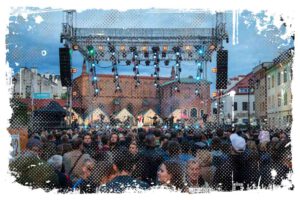I think traditional Krakow attire and dresses for women are quite interesting. Being in Kraków, you need to know about these details to fully appreciate its culture and tradition. So, let’s start and picture this. Every day, the women in Krakow wore a hip-length white shirt, a simple yet elegant piece. They often added a little extra, called a „dimple”, made from thicker linen that served as their underwear.

The everyday shirt was a bit plain, but on Sundays, a shirt designed for church or satiate events came out. This one had no „dimple”, but it more than made up for it with rich, white embroidery. Trust me when I say, this was the pride of Krakow, especially the skilled embroiderers in places like Maków and Tyniec.
- I suggest you also read this: Poland’s Culture Clothing – Discovering Regional Traditions
And let’s not forget about the pleated skirt. I am convinced that skirts in the old days had their charm. They were often plain, with white being the choice for Podgórze locals, yellow and green for the folks „from Skalbmierz„, and pink along the Raba. But with the arrival of affordable factory materials, floral patterns became the standard for Cracovian skirts.
Cracovian Dresses – Ceremonies with Style

Now, when attending ceremonies or going to church, a Krakow woman wore one or more white skirts underneath the main one. It’s worth to say that the more skirts, the merrier. But here’s a little piece of advice if you want to emulate this style. You need to ensure everything is tightly secured around the waist. This way, there’d be no room for people to gssip, accusing the girl of „losing her mind”.
↳ Make sure to read my guide to the most amazing places to stay in Kraków:
How to Find Best Place to Stay in Krakow Old Town – Your Guide
Speaking of girls, you may also like to read this article I wrote: Exploring Poland’s Beauty Standards – Insights into Girls’ Perception
To add to this outfit, they wore an apron, also known as a „dimper”, over the skirt. This apron, especially the parade version, was made of thin, white linen, slightly shorter than the skirt, and adorned with a thick strip of white embroidery at the bottom.
The All-In-One Linen Belt

Another interesting feature is the linen belt. In the past, when traveling to Krakow, peasant women wore this belt under their apron. It came with a purse attached to it, which served as their money pocket. The keys to their home chests were also tied to this belt. Ideally, a Cracovian woman returning from the market would have a full purse. But remember, you might want to keep it cool on the language and customs of the local vendors, as they smetimes can be a bit unrefined.
The Cracovian Corset – A Work of Art

I believe it’s time we talked about the most luxurious piece in the Cracovian woman’s wardrobe – the corset. This sleeveless garment, reaching to the waist, is nothing short of a work of art. Crafted from damask or black and red velvet, and lined with red cloth, it catches the eye.
The corset features densely folded, semi-circular folds at the bottom, also known as 'organs’ or ’kalitki,’ adorned with a red hem. The front is so heavily embellished, it sometimes takes the form of rigid armor, which I think adds to its grandeur.
Just when you think you’ve seen it all, there’s more. Let me say that the Cracovian corset was just the beginning. It’s beautifully adorned with three rows of pearl buttons, sequins, and beads sewn on, plus shiny squiggles embroidered with gold and silver thread. The back, which used to be free of any decorations, is now filled with patterns too, thanks to the advent of machine embroidery in the 19th century. I think the floral motifs, especially those featuring flowers in vases or pots, are the most eye-catching.
Traditional Krakow’s Winter Wardrobe – When the Temperature Drops
A Cracovian woman’s winter wardrobe was quite a sight to behold. Imagine a knee-length dress made of navy blue or black cloth, equipped with a standing collar, lined with white lambskin, and embroidered with gold braid. This glamorous winter outfit, also known as a 'friend,’ was only worn by married women.

For the younger girls, they had to make do with a caftan, which was essentially a corset with sleeves. When it was cold, they wrapped a woolen scarf around their shoulders to stay warm.
Hair and Headgear – Statements of Status
In the summertime, instead of scarves, they wore ceremonial tights. These were strips of white linen richly decorated with white embroidery. How a woman styled her hair or what she wore on her head often indicated her marital status.
Unmarried girls would usually go bareheaded in summer and wrap a handkerchief around their heads in winter. A girl looking for marriage would pin flowers in her hair and show off her long braids. Upon marriage, her hair would be cut and a bonnet, or a ’oczepiny,’ would be ceremonially placed on her head. The bonnet was a specially folded white scarf tied on the forehead or the side.
Recognizing the Village Through the Bonnet
Interestingly, the way the bonnet was tied could tell you the village the woman came from. This headgear was quite complex to arrange, so much so that specialists in the villages would prepare them for a fee. Once married, a woman was never allowed to let her hair grow long or put flowers in it.
Fashion Footnote – No Shoes
I can tell you one surprising thing about the everyday life of Krakow women. They didn’t wear shoes. Yes, you heard it right, they went barefoot.
Even when going to church on Sundays, they carried their shoes in their hands to keep them from getting damaged. In winter, they’d wear high black boots, similar to the ones men wore.
Now, onto the finishing touches. Red beads were the most prized adornment. These were often passed down from mother to daughter as a treasured family heirloom. They also wore silk ribbons, often gifted by admirers, and a silver ring with coral and a red shirt ribbon was considered a charming gift from a suitor.
References:
- https://pl.wikipedia.org/wiki/Str%C3%B3j_krakowski



